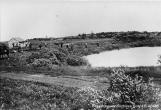15
"The country around Humboldt in this early summer was perfectly beautiful. The ground was fairly carpeted with wild flowers of every variety. The country on one side of us for twenty miles was rolling prairie, with clumps of trees dotted about everywhere, with small lakes and ponds, the grass in the open stretches clean and fairly short, so that the whole place looked like an enormous old country park.""We left Humboldt on July 9th, on a dull morning. The column consisted of the Body Guard and the provisional battalion, made up from the 12th York Rangers and the 35th Simcoe Foresters, under the command of Lieut.-Colonel W.E. O'Brien. These two corps marched so well that I dubbed them my "foot cavalry." We left Humboldt at 8 am on July 9th, and arrived at Fort Qu'Appelle at 11 am on the 13th; a distance of about one hundred and forty miles, in four days and three hours. I was astonished day after day to see how those men marched. Of course it was in lovely weather, over excellent roads. There was no enemy to fear, and they were allowed to march in the easiest way."
Excerpts from Soldiering in Canada: Recollections and Experiences by Lt. Col. George T. Denison.
20
Humboldt also had been garrisoned by the Governor-General's Body Guard in 1885. The Body Guard, under Lieutenant Colonel G.T. Denison provided scouting and outpost duties.Lieut-Col. G. T. Denison
Major Dunn
Captain Denison
Lieut. Merritt
Quartermaster Charles Mair
Lieut. Fleming
Surgeon Baldwin
22
An interesting story from the troops at Humboldt in 1885 features the "Humboldt Stone".On May 29, 1885, while the troops of General Middleton were marching to Batoche, they camped on the north bank of Humboldt Lake (known as Stoney), three and a half miles south of present day Humboldt. Awaiting orders to proceed, a young soldier by the name of Edwin Wernham belonging to the No. 7 Company, 12th Battalion, of the York Rangers, carved the following inscription on a stone, "No. 7 Co., 12th Batt., May 29th '85".
This stone laid unnoticed, for some 39 years, until June 15, 1924, when some boys, who were playing on the banks of the lake came across it. They told Mr. Anton Mettle about this stone, who retrieved it and brought it into Humboldt and placed it in the Arlington Hotel. Bishop Lloyd, during a visit to Humboldt, in that same year was shown this stone. He became interested in finding the man who had carved this inscription. He had a notice posted in the eastern papers, giving the full details of this discovery.
23
Artist's depiction of the Humboldt stone, painted by Dr. Zygmont Kondzielewski and Urban Lukan.2001

24
In due time, the notice came to the attention of the man who had carved the inscription on the stone, Edwin Wernham, who was living in Holland Landing, Ontario. He wrote letters to both Bishop Lloyd and Anton Mettle. He stated in these letters, that he was the person who carved his name on the stone. Mr. Wernham wrote that, "he was 74 years of age and still going strong, but says he is not as good a man as he was in '85." At this point in his life, he stated that he was the only remaining living member of the York Rangers, who had gone to the resistance. He also related that in his possession he still retained a piece of biscuit (hard tack) that was served to the troops at that time.Over the subsequent years this stone went missing. Despite considerable effort to track down the stone, it has not, as of yet, been located.





